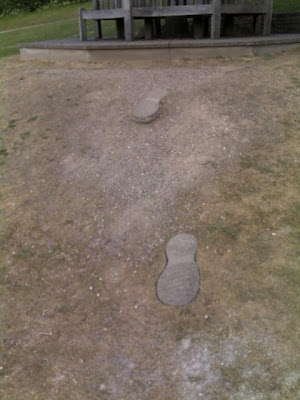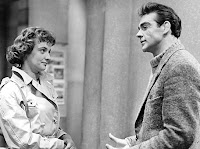 The Sagas of the Icelanders is a 780-page brick of a book, a selection of the best sagas from the newly translated and spangly complete collection. It's a lovely edition, printed on thick paper cut like crinkly chips.
The Sagas of the Icelanders is a 780-page brick of a book, a selection of the best sagas from the newly translated and spangly complete collection. It's a lovely edition, printed on thick paper cut like crinkly chips.The sagas are fascinating, a collection of histories and adventures about the earliest settlers of Iceland, from about 800 to 1100 AD, and written down a couple of hundred years later (so roughly contemporary with Chaucer). They're a rich and vivid window onto the culture I'd previously read about in my chum Jonathan Clements' Brief History of the Vikings.
The sagas tell of the lives of particularly noteworthy individuals and their families. They explain why different families left Norway and Denmark, how places in Iceland were named and how the land was divided up and fought over. Characters appear in more than one saga, so the stories build up a rich and cross-referenced history packed with detail.
As the Vikings trade with, explore and raid other countries, we get glimpses of Denmark, England, Finland, Ireland, North America, Norway and Scotland – and their kings – as well as meeting characters from Rome and Russia. There are all sorts of morsels to be gleaned from this, such as on language:
"King Ethelred, the song of Edgar, was ruling England at that time. He was a good ruler, and was spending that winter in London. In those days, the language in England was the same as that spoken in Norway and Denmark, but there was a change of language when William the Bastard conquered England. Since William was of French descent [though, er, also a Norman or Norseman], the French language was used in England from then on.”Or there's the insights into contemporary fashion, for example the kjafal, worn in Scotland by both men and women:Katrina C Attwood (trans.), 'The Saga of Gunnlaug Serpent-Tongue' in The Sagas of the Icelanders, p. 572.
"which had a hood at the top but no arms, and was opens at the sides and fastened between the legs with a button and loop; they wore nothing else.”We also learn about romance. There are plenty of loving relationships and a fair few nagging wives. And then there's this telling detail about a lover who knows her business:Keneva Kunz (trans.), 'Eirik the Red's Saga', in ibid., p. 667.
“She welcomed him warmly and offered to search his hair for lice.”While the sagas spare none of the explicit details when it comes to violence, they're coy about the rude stuff. Gisli falls out with his wife, whose gossiping can only lead to trouble. He's so appalled by her, he won't let her in his bed. But she's not taking no for an answer as she climbs in beside him:Keneva Kunz (trans), 'The Saga of the People of Laxarddal',p. 342.
"She soon made clear what she wanted to do, and they had not been lying together for too long before they made up as if nothing had happened.”Generally the sagas tell us two things: what people were like and what they fought over.Martin S Regal (trans), 'Gisli Sursson's Saga', p. 511.
Egil Skallagrimsson, star of his own saga and a cameo in several others, is tall, bald and generally bad news. He continually causes trouble, saying the wrong thing or killing the wrong people, leaving his mates to sort out the mess. On no account should Egil ever be allowed near booze.
"Egil ... stood up and walked across the floor to where Armod was sitting, seized him by the shoulders and thrust him up against a wall-post. Then Egil spewed a torrent of vomit that gushed all over Armod's face, filling his eyes and nostrils and mouth and pouring down his beard and chest. Armod was close to choking, and when he managed to let out his breath, a jet of vomit gushed out with it. All Armod's men who were there said that Egil had done a base and despicable deed by not going outside when he needed to vomit, but had made a spectacle of himself in the drinking-room instead.A page later, for no other reason than to add injury to insult, Egil kills Armod. But that's apparently okay because a) Egil is a big guy who's good at fighting and b) he has a line in sarcastic poetry. The saga continues in broadly the same vein until, in his 80s, Egil manages to start one last scrap before he dies.
Egil said, 'Don't blame me for following the master of the house's example. He's spewing his guts up just as much as I am.'
Then Egil went over to his place, sat down and asked for a drink.”Bernard Scudder (trans) 'Egil's Saga' in ibid., p.139.
There are plenty of other mischievous, selfish and unlikely characters. 'The Saga of the People of Laxardal' is full of strong women, but it's Freydis in 'Eirek the Red's Saga' that most strikes a chord. She's pregnant when some Native Americans / Injuns attack, but berates the other Vikings for running off. Then she spots a dead man:
"His sword lay beside him, and this she snatched up and prepared to defend herself with it, as the natives approached her. Freeing one of her breasts from her shift, she smacked the sword with it. This frightened the natives, who turned and ran back to their boats and rowed away.”These are savage and pagan times, full of dark magic and dreams that predict the future. That said, the Vikings don't behave any different after they convert to Christianity. In fact, they are made to convert with nothing short of brute force:Keneva Kunz (trans), 'Eirek the Red's Saga' in ibid., p. 671.
"King Olaf sent his own royal cleric, a man named Thangbrand, to Iceland ... He preached the Christian faith with both fair words and dire punishments. Thangbrand killed two men who most opposed his teachings.”Christianity seems to co-opt many of the pagan traditions. The Vikings give gifts at winter festivals – men are judged not on what they own but what they give away. Then there are their naming ceremonies:Keneva Kunz (trans), 'The Saga of the People of Laxarddal', p. 352.
"vatni ausinn: Even before the arrival of Christianity, the Scandinavians practised a naming ceremony clearly similar to that involved in the modern-day 'christening'. It is mentioned in eddic poems such as Rigspula (The Chant of Rig), st. 21, and Havamal (The Sayings of the High One), st. 158. The action of sprinkling a child with water and naming it meant that the child was initiated into society. After this ceremony, a child could not be taken out to die of exposure (a common practice in pagan times).”The things these people fight over seem very familiar, too – they might have come from the plots of Charles Dickens. There's various examples of people getting snitty because their neighbours graze animals on their land. There's the fighting over inheritance, there's the perceived slights between families and friends, there's a long whispering campaign against a chap called Thorolf (there are quite a few in the book) by relations of his wife's first husband who feel they're entitled to part of his lands.Glossary, p. 756.
In fact, there's a lot on inheritance – money owed to children, but also the importance of good family and people knowing who your parents are. The implication is that there's virtue in blood. It's something that crops up in 19th Century novels, too. If this belief in the importance of blood has been long-ingrained by culture for 1,000 years, it might explain why it's been so difficult to get past.
Anyway, the chief difference from Dickens is the way these things get dealt with. On a few occasions, one neighbour murders the slaves of another, or sneaks in to the neighbour's house at night to do away with the neighbour. In a particularly grisly example, two 10 year-old children try to fight their fathers' battle and end up killing each other. Murder in Dickens is a Big Plot Thing, here it's an everyday occurrence.
But these things are also long remembered. Sons and grandsons seek revenge for slights visited on dead ancestors. The courts – or allthings – attempt settlements of disputes, but it's an odd process. On page 450, Hrafnkel is prevented from hearing the case made against him by a crowd outside the court. But he's a villain, so that's okay.
Often we're told that someone acted honourably or wisely when all he's done is butcher his enemies or bribed the judges. Honour is a major theme of the stories – and often a catalyst for things going wrong. For all the greed, ambition, sulking and stupidity on display, it's often long-standing oaths that get people in trouble.
The sagas struggle to draw moral lessons from these savage times, and – as with Beowulf – there are odd inconsistencies. Gisli, for example, finds himself ambushed by 12 men who've been wound up by his wife's rumours. He fights bravely:
“Then, when it was least expected, Gisli turned around and ran from the ridge up on the crag known as Einhamer. There, he faced them and defended himself.”But a page later, the odds are too much against him and he dies. The saga adds its own note on his heroism, and despite what we've just been told about him running back to a better position, tells us:Martin S Regal (trans), 'Gisli Sursson's Saga', p. 554.
“They say that he never once retreated.”In short, the sagas are full of rich adventure, vivid characters and telling details. But I can't help feeling they confirm the cliché of the Vikings as brutish, pillaging thugs. As a kid, a description of the Viking way of life struck me as downright cowardly. There's little in the sagas to convince me I was wrong.Ibid., p. 555.
"If the enemy was more powerful than you, you went away. If he could be defeated, you killed, imprisoned or enslaved. You were unswayed by pity or mercy.”Gerry Davis, “Prologue: The Creation of the Cybermen” in Doctor Who and the Cybermen (1974), p. 3.
































